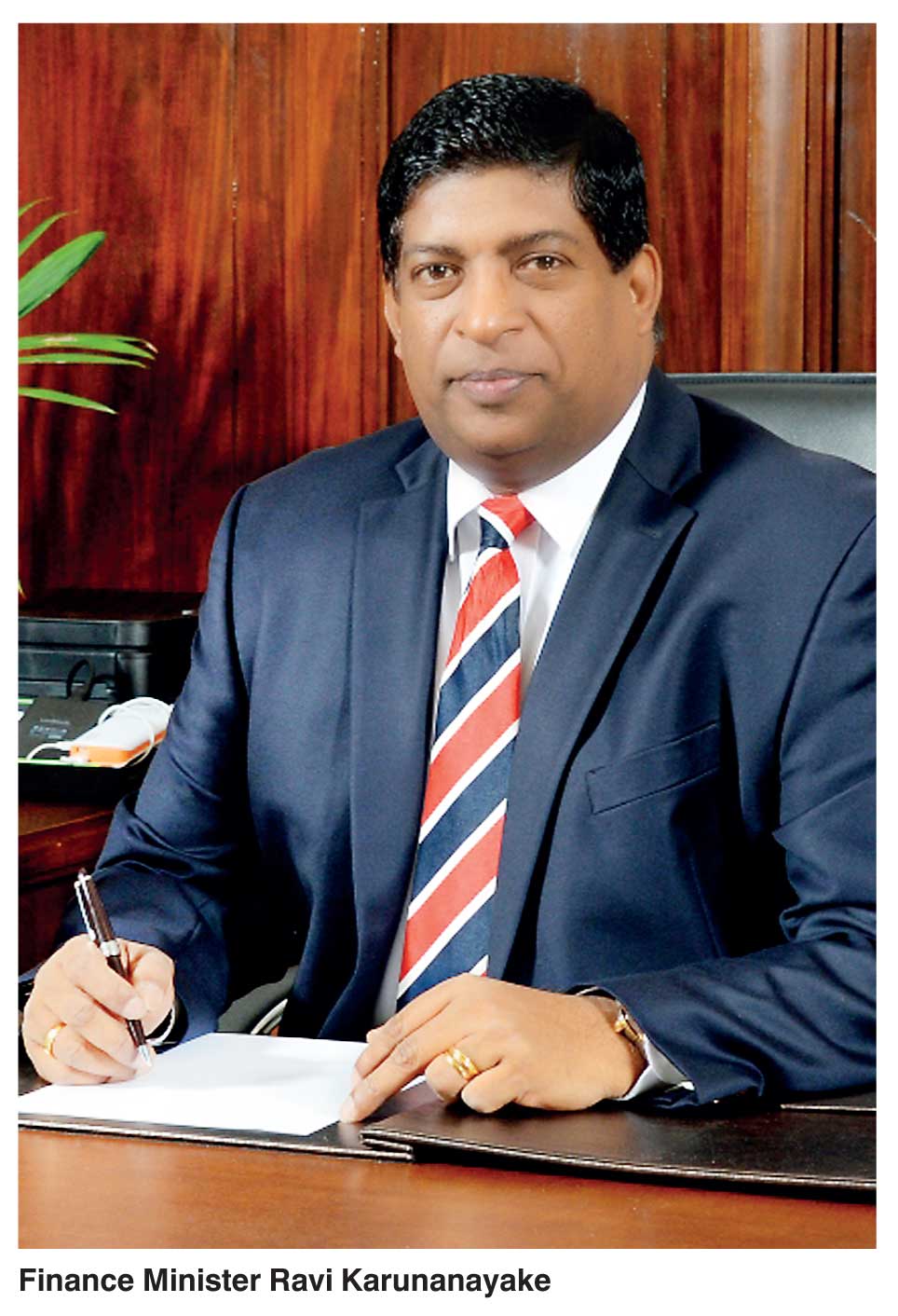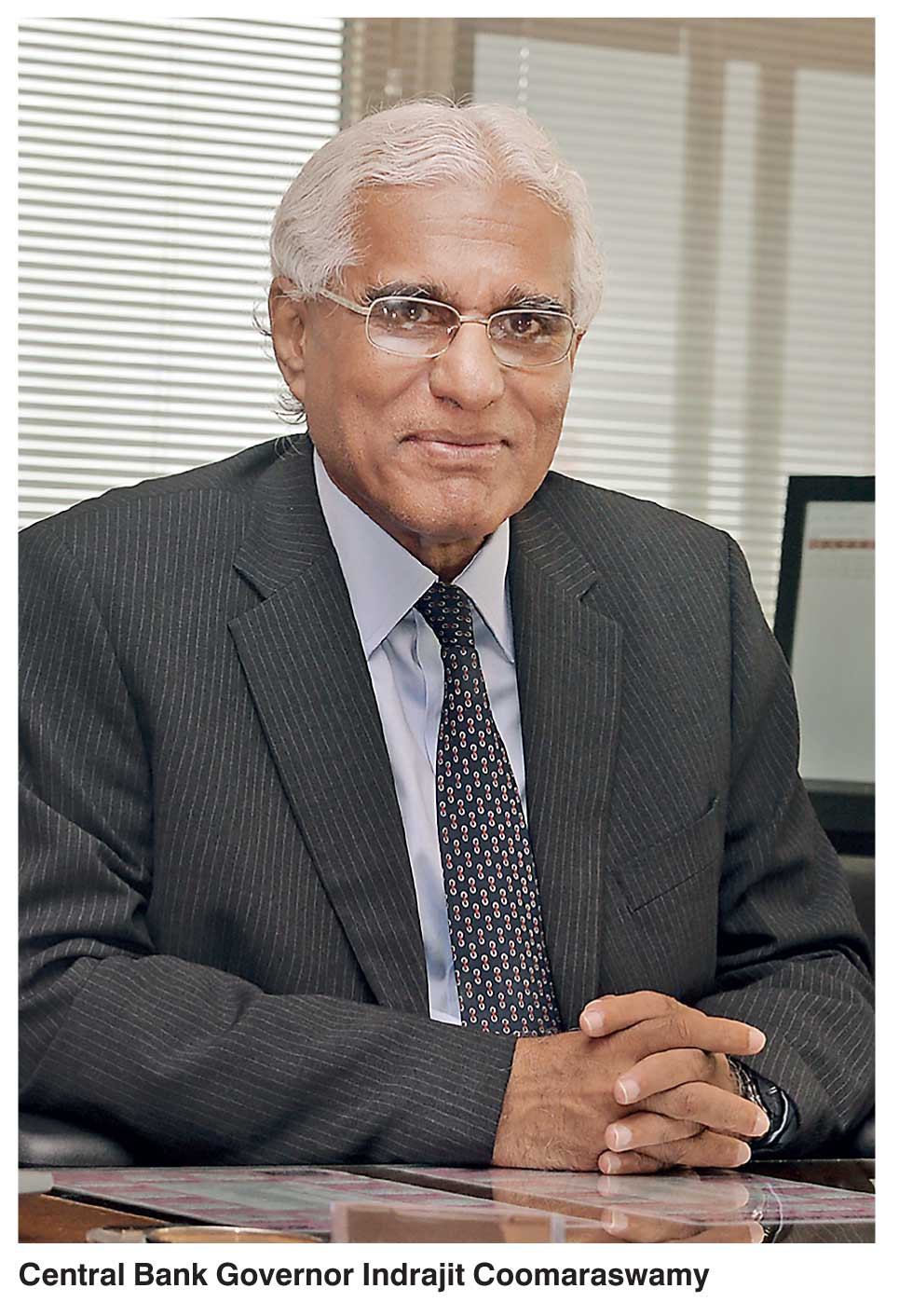Friday Mar 14, 2025
Friday Mar 14, 2025
Monday, 23 January 2017 00:38 - - {{hitsCtrl.values.hits}}
 An unsavoury rift between the Central Bank and Minister of Finance
An unsavoury rift between the Central Bank and Minister of Finance
A growing rift between Finance Minister Ravi Karunanayake and the senior management of the Central Bank is surfacing now, worrying both financial markets and prospective foreign investors. The relationship between the Finance Minister and the Monetary Board of the Central Bank is not very clear under the new work allocation of the Government.
In terms of this work allocation, the Central Bank, which should legitimately come under the Finance Minister, has been listed under the Minister of Economic Affairs of which the portfolio is being held by the Prime Minister himself. This was an unworkable work allocation and this writer pointed it out immediately after the relevant Gazette was issued by the government in January 2015 in a previous article in this series (available at http://www.ft.lk/article/384736/Listing-Central-Bank-under-PM--Unworkable-legally-and-operationally-but-a-step-toward-bank-s-independence ).
The promised reform that was never delivered
The only hope about this bizarre work allocation at that time was it would help the Government to reform the Central Bank if it is placed directly under the Prime Minister. This was promised by the Prime Minister when he delivered the first economic policy statement in November 2015.
However, the subsequent events proved that the much needed reforms did not take place with regard to the Central Bank or the financial sector at large.
Instead, the financial markets and the good governance activists were startled by a bond scam within the Central Bank about which the Government did not take any effective action in terms of its mandate to establish a clean society in the country. Its ripples are still rising ominously in ever increasing intensity worrying the government and shaking it to its foundation because, contrary to the Government’s expectation that it would die out soon, the civil society activists have not stopped pestering it for justice.
Finance Minister’s attempt at grabbing the powers vested with the Central Bank
Against this backdrop, the Finance Minister, obviously worried about the truncation of his powers, has attempted to grab them informally by interfering in the work of the Central Bank.
There was a report that the Finance Minister had walked into a meeting of the primary dealers in the Central Bank unannounced voicing his dissatisfaction openly about the bank’s performance (available at: http://www.sundaytimes.lk/150329/business-times/ravi-attends-primary-dealers-meeting-at-central-bank-141371.html).
This was unprecedented because none of his predecessors had resorted to that kind of tactic and it certainly would have frightened the Central Bank officers as well as the primary dealers present at the meeting.
Then, there was an attempt at grabbing the legitimate functions of the Monetary Board such as fixing the value at which the banks should lend to vehicle buyers. In Budget 2017, there were a large number of budget proposals which would have been attended to by the Monetary Board under the powers vested with it by law. As this writer had pointed out, it had diminished the value of the Budget which had taken some positive measures to reform the country’s ailing fiscal sector (available at: http://www.ft.lk/article/580074/Budget-2017--Significant-improvement-if-not-marred-by-policy-inconsistencies-and-interference-with-the-Monetary-Board).
Then, it became a vocal battle in which Finance Minister Karunanayake is reported to have criticised the Governor of the Central Bank and its senior officers in public. Apparently dismayed by Governor Indrajit Coomaraswamy’s open and frank assessment of the state of the economy in the address he delivered when launching the Central Bank’s Road Map for 2017 and Beyond in early January 2017, it was reported that the Minister had equated the Governor to a hospital attendant who had helped the previous administration to send the economy, the chronic and acute patient, to the intensive care unit or ICU of the hospital. The Minister is reported to have said that it was he who had taken the patient out of ICU.
The Governor’s right to speak the truth and how it would help the government to build a sound economy were analysed by this writer in a previous article in this series (available at: http://www.ft.lk/article/590141/When-a-Governor--speaks-like-a-Governor-----).
Though the Minister had pacified the Governor later calling him a “good soul”, he had at the same time castigated two or three senior officers of the Bank for conspiring to depreciate the value of the rupee in the international markets, a move to embarrass the government, in his opinion. He had even threatened to reveal the names of these officers in the days to come (available at: http://www.dailymirror.lk/article/Ravi-K-vows-to-reveal-names-of-Central-Bank-saboteurs-busting-rupee-122195.html). Minister Karunanayake had, according to the report, vowed to stabilise the exchange rate which is now under pressure for depreciation within two months. If he fails, it implies that it is due to the sabotage of his work by the two or three unnamed saboteurs in the Central Bank.
John Exter’s advice to Minister of Finance and Central Bank: Grow and mature
This is a battle between politicians and professionals which is not totally unexpected. The architect of the Central Bank, John Exter, too predicted a situation in which the central bank management and the politicians might be embattled in conflicts which is not savoury for the smooth functioning of the economy.
He had noted, in the report he submitted to the Government on the establishment of a central bank in the country, known as the Exter Report, that such conflicts would be more intensive in times of economic crises than in times of economic stability. Thus, the current situation has provided a fertile ground for the battles to be intensified. Hence, he had proposed in the Exter Report that there should be “continuous and constructive cooperation between the Monetary Board and the Government” (p 12). The Secretary to the Ministry of Finance, who is a member of the Monetary Board, is to act as the conduit for such cooperation by making the views of the Minister or the government known to the Monetary Board. However, the final outcome of such cooperation will depend on the maturity and experience of the men occupying the key positions in the Central Bank and the Ministry of Finance. It is something to be attained through “experience and the slow growth of political conventions” (p 13).
 Past attempts at steamrolling the Central Bank
Past attempts at steamrolling the Central Bank
These noble expectations of John Exter have not materialised in Sri Lanka even after 67 years of political independence. Instead of extending cooperation, there have been attempts by politicians at steamrolling the Central Bank at various times.
In 1959, the Government of the late Wijayananda Dahanayake issued a directive to the Monetary Board to reduce interest in an attempt to win the forthcoming elections, but it was voted out of power soon after. In 1976, the then Minister of Finance, the Late Felix R Dias Bandaranaike, angered by a frank report filed by the then Director of Economic Research, the late H.N.S. Karunatillake, that the nationalisation of the plantation industry was marred with a number of deficiencies, prevailed upon the Monetary Board to transfer the latter out of the Economic Research Department. This was corrected only after the fall of that government in 1977.
Then, in 2004 when this writer was the Deputy Governor of the Bank, he was accused by Mangala Samaraweera, then a powerful Minister of the Government, and Parliamentarian Wimal Weerawansa that this writer was conspiring with the opposition to depreciate the exchange rate. This charge was made in the media, live television discussions and press conferences. It was left to Governor Sunil Mendis to invite Parliamentarian Wimal Weerawansa to the bank and give a basic lecture, similar to the basic economics course known as 101 Economics in the parlance of universities, as to how the exchange rate of a country is determined.
To his credit, Parliamentarian Weerawansa never made that accusation again. What is happening today is a repeat exercise of that episode with different actors playing key roles. What is incomprehensible is that a seasoned politician like Minister Ravi Karunanayake, who has fought vigorously for establishing a “responsible government” in the country, resorting to hurling accusations at unnamed central bank officers when economic truth has been something else.
Can exchange rate be fixed by politicians or central bank officers?
Can two or three officers of the bank acting in conspiracy cause the rupee to depreciate in the market? Anyone who has no knowledge of even the basic market practices might think so. However, markets are different and they cannot be manipulated by a few officers in the bank or in any other institution in the country for long. By the same token, even a Minister of Finance cannot stabilise the value of the rupee if it is on a continuous downward move.
The truth of this fact would have been obvious to Minister Ravi Karunanayake, who is reported to have vowed in late June 2015 that the rupee would be stabilised at around Rs 129 per dollar in two weeks (available at: http://www.lankabusinessonline.com/sri-lanka-to-strengthen-rupee-to-129-in-two-weeks-finance-minister/ ). Instead of Rs. 129, it ended up at Rs. 144 per dollar by the end of 2015 and Rs. 151 by the end of 2016.
The reality behind the determination of the exchange rate
How is the exchange rate of a country determined? This could be illustrated by a simple example as follows.
An exchange rate is a price and here the price is the expression of the value of one currency in term of another currency. For instance, the price of the US Dollar in terms of Sri Lanka Rupee is that one Dollar is equal to Rs. 151. At this price, for any Sri Lankan to buy a Dollar, he should spend Rs. 151. Conversely, for any foreigner to buy a Rupee, he should bring less than one US cent.
The popular fallacy is that the government can fix this rate at any level it wishes. For instance, the fallacy says that, if the government wishes, it can fix the rate of the Dollar at Rs. 100 or even below. Can this be done? The answer is both yes and no.
‘Yes’ if the domestic purchasing power of the Rupee has improved against the Dollar so that anyone who has acquired a Rupee has the same purchasing power as a holder of a Dollar at the new rate. This was presented by the Swedish economist Gustav Cassel nearly a year ago in a celebrated theory known as the ‘Purchasing Power Parity’. What he said was that when there are two different price levels in two different countries, the exchange rate moves appropriately to make the purchasing power of the two currencies equal to each other, or in other words, to make operation of the purchasing power parity.
‘No’ if the true purchasing power parity is not what the government has mandated its currency to have as its international value.
This could be understood by examining the following simple example.
What is a Rupee to a foreigner? It is an entitlement to buy a basket of goods and services from Sri Lanka’s economy worth Rs. 1. That is determined by the domestic price levels. Similarly, a Dollar to a Sri Lankan is the entitlement to buy a Dollar’s worth of goods and services from the US economy.
Therefore, when a country announces its exchange rate, it tells the rest of the world that ‘come and buy a Rupee’s worth of goods and services from our country by exchanging your currency for ours’. Hence, when the exchange rate is fixed at an appreciated value, it tells the rest of the world that they should bring more foreign currencies to buy those goods and services. It is a way of raising the value of domestic goods and services to foreigners.
Suppose for example that a potato seller at Delkanda Pola announces that his potatoes are sold for Rs. 10,000 per kilo. Can he sell his potatoes at that price? Yes if the potatoes are sold for the same price in other Polas as well. But if potatoes are sold for Rs. 100 per kilo at Nugegoda and the transport cost and other inconveniences to travel to Nugegoda are simply Rs. 10, a buyer would move to Nugegoda and buy his potatoes. The Delkanda Pola potato seller is therefore forced to bring down his price to a level of Rs. 110 per kilo to make his potatoes as equally attractive as those at Nugegoda.
Purchasing power parity
This is ‘purchasing power parity’ and according to it, price differences could occur in two different markets only to the extent of the existence of transportation costs and other inconveniences commonly known as transaction costs.
Let’s now apply this analogy to the exchange rate. Suppose that the government announces to the rest of the world that the value of Rupee is on par with the Dollar, that is, anyone wishing to get a Rupee should bring a Dollar with him. Suppose further that the domestic price of tea is Rs 500 per kilo. Then, for an American to buy a kilo of tea, he should bring $ 500. This is like the Delkanda Pola potato seller announcing that his potatoes are priced at Rs. 10,000 a kilo. Will the American buy tea from Sri Lanka? Yes, if tea prices in all other places are $ 500 a kilo. But since the American can buy a kilo of tea for $ 4.50 from neighbouring India, for him to buy tea at $ 500 a kilo from Sri Lanka, he should be an extremely stupid person.
So, to make Sri Lanka tea as attractive as Indian tea and induce foreigners to buy Sri Lankan tea, the exchange rate should be depreciated to Rs 111 a Dollar. This is sad and frustrating, but unavoidable as long as domestic tea prices remain at Rs 500 a kilo.
Since a country produces a variety of goods and services, it is not a single price like tea that would apply, but the general price level that represents the prices of all the goods and services. This is measured by consumer price indices and their increase over a long period is known as ‘domestic inflation’. Hence, for a government to maintain an appreciated exchange rate, it should necessarily keep its inflation lower than that of other competitive countries.
If the domestic inflation is at a higher level, as is the present case in Sri Lanka where inflation runs on average at 4% per annum according to the latest data but has been on average at around 9% per annum over the past decade, any artificial appreciation of the exchange rate through other means will not be sustainable.
The bitter economic reality that is not palatable
This was the truth that was pronounced by Governor Indrajit Coomaraswamy in his address at the launch of the bank’s Road Map for 2017. It is a truth which Minister Ravi Karunanayake has failed to accept. As long as this rift proliferates, it boomerangs on the good governance government led by both President Maithripala Sirisena and Prime Minister Ranil Wickeremasinghe. Hence, it is advisable that it be settled early.
(W.A. Wijewardena, a former Deputy Governor of the Central Bank of Sri Lanka, can be reached at [email protected])

Discover Kapruka, the leading online shopping platform in Sri Lanka, where you can conveniently send Gifts and Flowers to your loved ones for any event including Valentine ’s Day. Explore a wide range of popular Shopping Categories on Kapruka, including Toys, Groceries, Electronics, Birthday Cakes, Fruits, Chocolates, Flower Bouquets, Clothing, Watches, Lingerie, Gift Sets and Jewellery. Also if you’re interested in selling with Kapruka, Partner Central by Kapruka is the best solution to start with. Moreover, through Kapruka Global Shop, you can also enjoy the convenience of purchasing products from renowned platforms like Amazon and eBay and have them delivered to Sri Lanka.
Discover Kapruka, the leading online shopping platform in Sri Lanka, where you can conveniently send Gifts and Flowers to your loved ones for any event including Valentine ’s Day. Explore a wide range of popular Shopping Categories on Kapruka, including Toys, Groceries, Electronics, Birthday Cakes, Fruits, Chocolates, Flower Bouquets, Clothing, Watches, Lingerie, Gift Sets and Jewellery. Also if you’re interested in selling with Kapruka, Partner Central by Kapruka is the best solution to start with. Moreover, through Kapruka Global Shop, you can also enjoy the convenience of purchasing products from renowned platforms like Amazon and eBay and have them delivered to Sri Lanka.